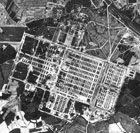
New Jersey 40.76N x 70.42W 2004
Distributed by Cinema Guild, 115 West 30th Street, Suite 800, New York, NY 10001; 212-685-6242
Produced by Andrew K. Stauffer
Directed by Howard Libov
VHS, color, 30 min.
Sr. High - Adult
Jewish Studies, Art, Holocaust and Genocide Studies, World War II
Date Entered: 11/19/2004
Reviewed by Lisa Flanzraich, Queens College, Flushing, New YorkArtist Arie Gallas tells us both a horrific yet moving story through his charcoal drawings entitled Fourteen Stations. Based on Luftwaffe aerial photographs taken for field reconnaissance and military surveillance, Gallas exposes these configurations to reveal Nazi concentration camps in Poland. He magnifies the images to render evidence of what took place in the peaceful woods and forests masking the gas chambers. The viewer recalls the opening scenes of Claude Lanzmann’s 1985 landmark Holocaust documentary, Shoah. In it, the camera pans lovely fields and records the sounds of a babbling river to mark the concentration camp, Chelmno, where 400,000 Jews were murdered.
Gallas’s message is loud and clear: “Never Forget.” A child Holocaust survivor himself, who fled with his parents to Russia following the German invasion of Poland, Gallas uses the photographs as “point of departure” to reinterpret history. Created over a period of ten years, his charcoal drawings document the railroad tracks, barracks, roads and crematoria of an unimaginable hell with painstaking precision. While he is spellbound by the “hypnotic beauty of the photographs from the air,” from an aesthetic point of view, his formidable opus punches us in our faces. We see only the ugly irony of truth.
Gallas speaks with eloquence, sadness, and passion. He speaks of himself as an “archaeologist pulling out the details from the rubble of history.” Through research at the National Archives, plus his own keen eye and command of historical facts, he discovers a covert concentration camp, Gross-Rosen, near his birthplace in Poland. It is a poignant moment on camera and Gallas articulates his emotions befitting such a traumatic discovery.
Minor flaws include the omission of Gallas’s age when he fled from Poland, when and how he and his family emigrated to the U.S., the city or town in New Jersey where he lives and works, and where Fourteen Stations was initially exhibited. This production also needs a better title than New Jersey 40.76N x 70.42W. That is too obscure. Simply naming it Fourteen Stations would have been more appropriate and unnerving in light of the fourteen stations of the Passion of Christ.
However, the director has done a fine job in weaving Gallas’s biography, creative process, and vision together into a complete story. Moreover, we appreciate the artist’s profound dedication to the memory of the slaughtered millions who died during the Holocaust.